The Philips PML 9009 is the brand's flagship LCD television with Mini LED backlighting. It boasts impressive build quality, a stylish remote, and Philips' unique multicoloured Ambilight feature. In terms of picture quality, black levels and contrast could be improved—they don’t quite match the depth and vibrancy offered by similarly priced competitors. However, thanks to effective image algorithms, tonal quality remains satisfying. The screen’s relatively low brightness is well managed, and the inclusion of Dolby Vision provides a gateway to HDR content. The TV’s smooth colour transitions are noteworthy, surpassing some higher-end models. The PML 9009 truly excels in gaming performance, offering an experience that will please any gamer. Its motion-smoothing system also deserves praise, with two adjustable sliders allowing users to select their preferred smoothing level, making it a solid choice for sports viewing. Although the TitanOS operating system is still evolving and lacks a wide range of apps, the manufacturer is expected to address this over time.
- Matching (Score)
- Our verdict
- TV appearance
- Where to buy
- Contrast and black detail
- HDR effect quality
- Factory color reproduction
- Color reproduction after calibration
- Smoothness of tonal transitions
- Image scaling and smoothness of tonal transitions
- Blur and motion smoothness
- Console compatibility and gaming features
- Input lag
- Compatibility with PC
- Viewing angles
- TV efficiency during daytime
- Details about the matrix
- TV features
- Apps
- Playing files from USB
- Sound
Philips PML9009 / 9019 / 9059 vs TCL C7K / QM7K
Direct compare
The Xtra / PML9019 / PML9059 / PML9009 / PML9049 / AMBILIGHT TV
C7K / Q7C / MQLED85K / C79K / C71K / QM7K


Panel type: LCD VA
Resolution: 3840x2160
System: Titan OS
Model year: 2024
Complete the survey to find out the result

Panel type: LCD VA
Resolution: 3840x2160
System: Google TV
Model year: 2025
Complete the survey to find out the result

Overall rating
6.8
7.1
Movies and series in UHD quality
6.5
6.7
Classic TV, YouTube
6.3
6.5
Sports broadcasts (TV and apps)
6.6
6.4
Gaming on console
8.5
8.5
TV as a computer monitor
8.6
8.4
Watching in bright light
6.1
6.1
Utility functions
6.0
7.7
Apps
6.2
9.6
Sound quality
6.7
7.0
Complete the survey to find out what fits your preferences
Advantages
Superb tonal quality of scenes exceeding the capabilities of the television
Well-functioning dynamic tone mapping feature
Colour reproduction after calibration
Performance when connected to a console/PC
Very good black - VA panel with a large number of Mini-LED zones
High brightness in HDR - over 1000 nits
Great for gamers - HDMI 2.1, low input lag, VRR, ALLM, etc.
Good motion fluidity - 144Hz panel
Support for multiple HDR formats: HDR10, HDR10+, Dolby Vision
Google TV operating system with access to a huge app base
Pleasant sound from built-in speakers
Disadvantages
Significant halo/bloom effect
Poor viewing angles
TitanOs system is not as advanced as the competition
Average contrast and black levels
Google TV can work with minor lags
No USB recording and PiP features
Our verdict
There are TVs that come in for testing and you immediately think: "oh, another average one, probably like many others." And in fact… that's true. The TCL C7K doesn't try to dethrone the OLEDs, it doesn't shout from the box "revolution!". And yet, after a few days of testing, it's hard not to think: "wow, this is really good equipment." And that's exactly what the C7K is. The biggest asset of the C7K is its decent picture at a reasonable price – MiniLED and quantum dots do their job here. The colors are vibrant, the brightness is satisfactory, the contrast is impressive, and with the right settings, you can truly enjoy viewing in the best quality. The second strong point is the fluidity of motion – both in sports and in games. Support for HDMI 2.1, variable refresh rate, 144 Hz, and a whole bunch of other features make playing on this TV a pure pleasure. Additionally, there's Google TV, which – despite minor shortcomings – provides access to nearly an endless library of applications. Voice control, quick access to YouTube, Netflix, AirPlay support – everything you need for daily use is here. Are there any downsides? Sure. The Google TV system sometimes experiences moments of "hesitation," and MiniLED – like any MiniLED – can stumble on very challenging movie scenes. But those are details. After all, the C7K is a mid-range model – and in this class, it simply performs excellently. So if you are looking for a reasonably priced, modern TV with Google TV that looks good, works well, and sounds pretty decent without breaking your budget – the TCL C7K definitely deserves attention.
TV appearance





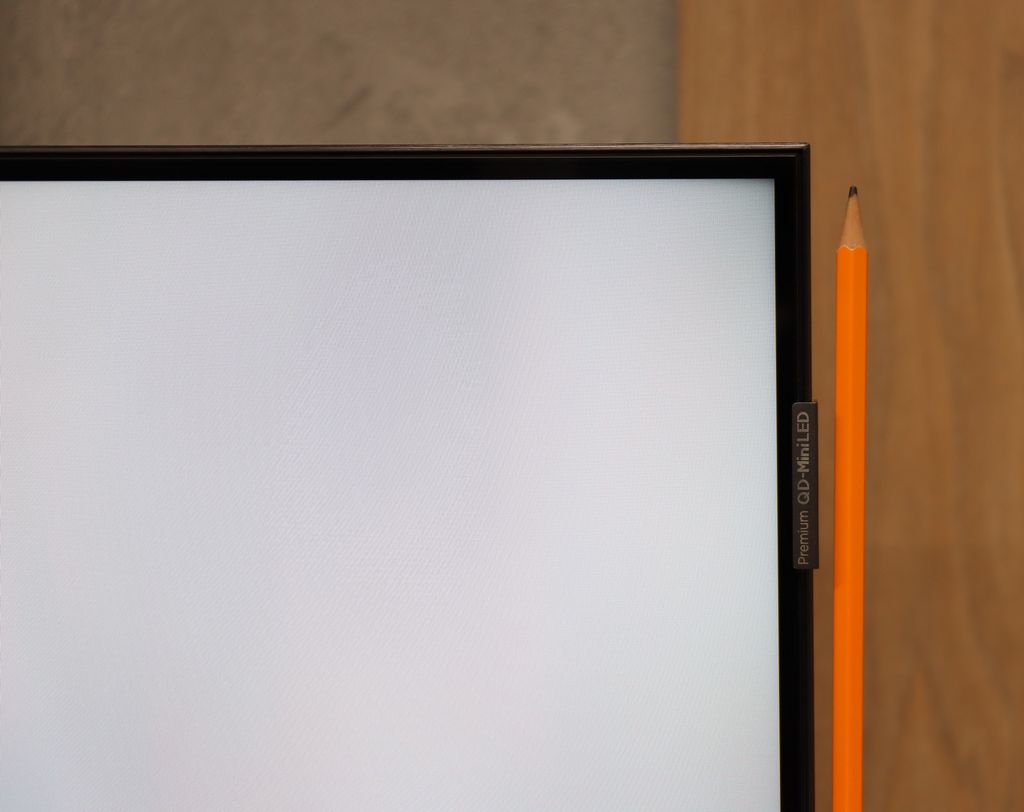
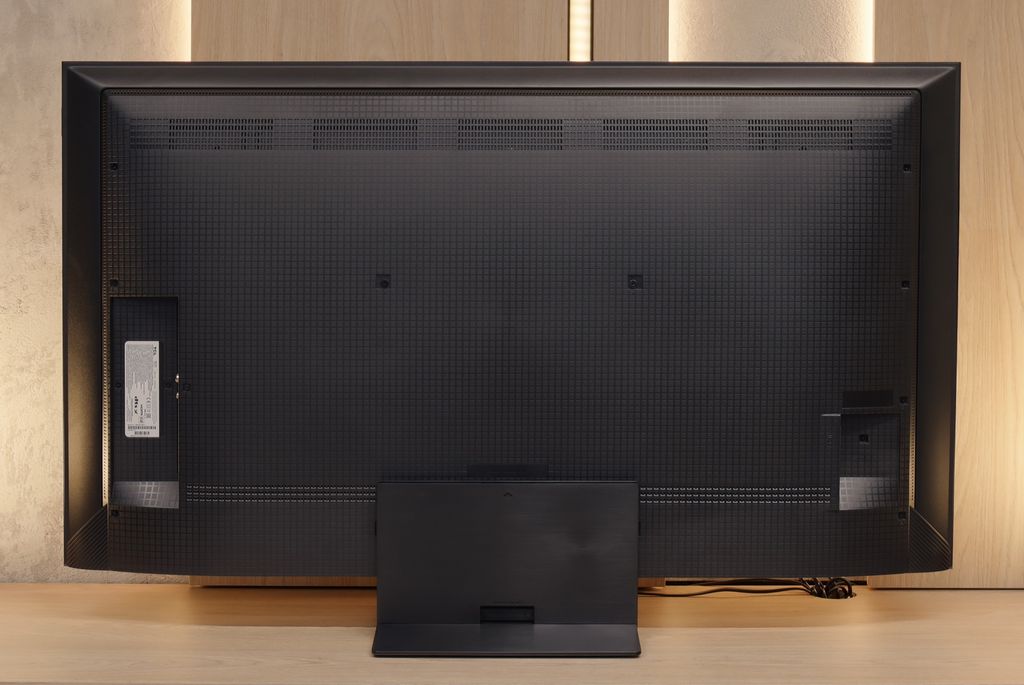
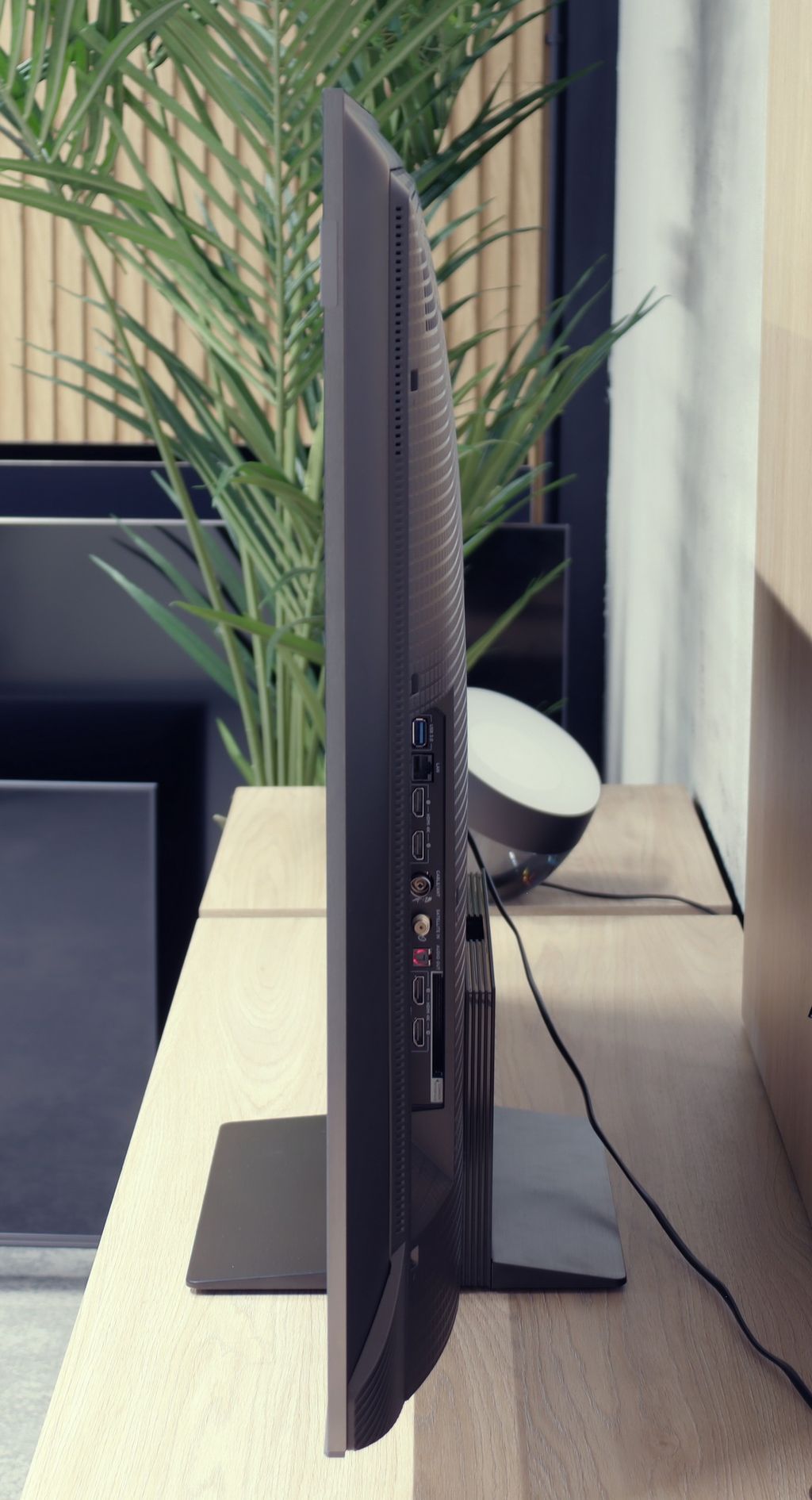
Contrast and black detail
6.6/10
7.1/10
Local dimming function: Yes, number of zones: 75 (15 x 5)
Local dimming function: Yes, number of zones: 336 (14 x 24)
Contrast:

Result
132,000:1

Result
16,550:1

Result
14,450:1

Result
7,850:1

Result
6,650:1

Result
161,000:1

Result
18,750:1

Result
13,150:1

Result
6,300:1

Result
4,200:1
Halo effect and black detail visibility:

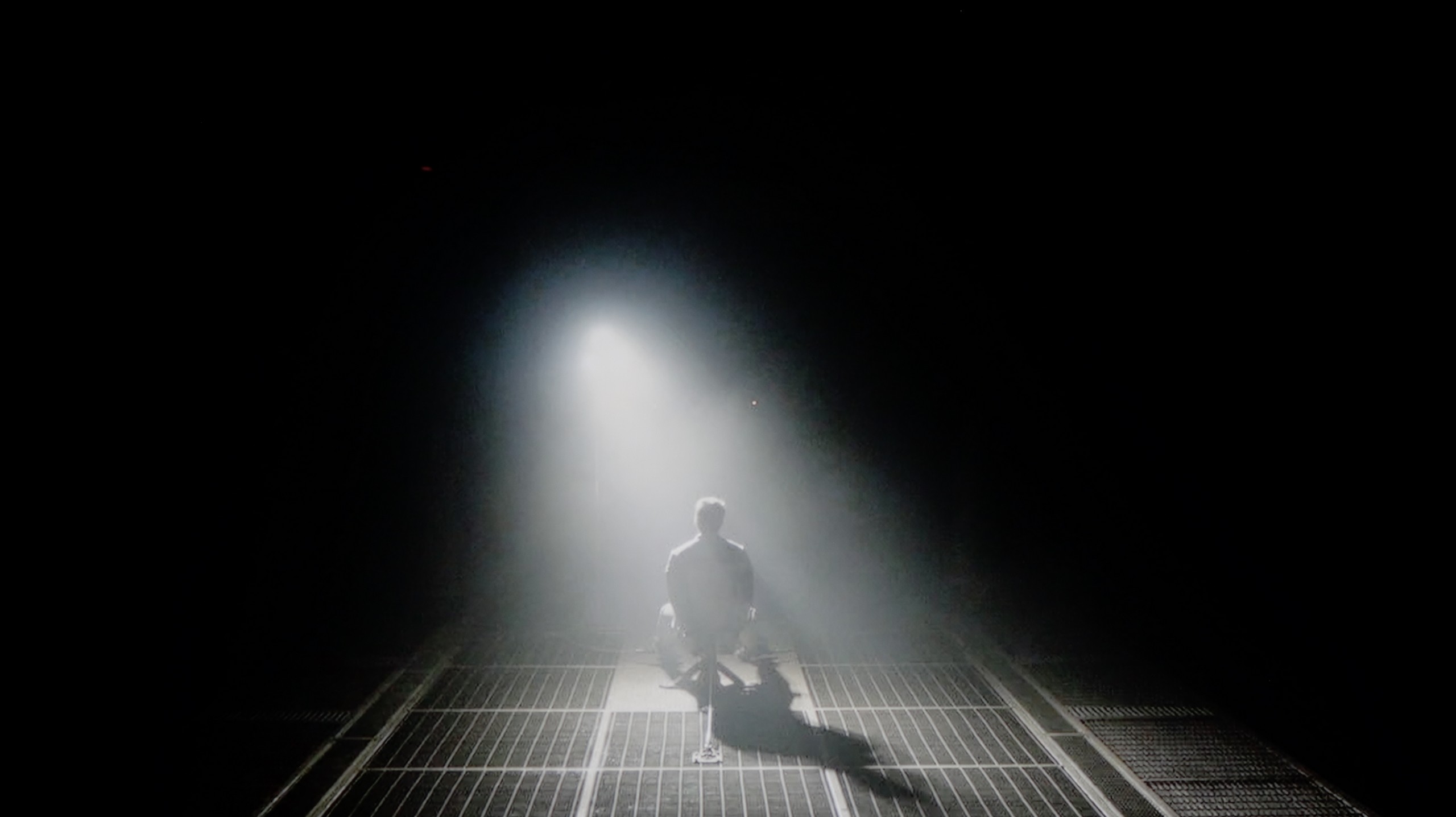
The Philips PML9009 features a high-contrast VA panel. While it doesn’t produce the same depth and dimensionality as OLED displays, it remains a solid choice for home cinema, outperforming IPS/ADS panels in this regard. The measured static contrast ratio, at 6000:1 without local dimming, is commendable and showcases the Mini LED backlighting capabilities of this model. Though the contrast and black level measurements aren’t among the highest, the television performed well in certain scenes, such as Oblivion, where it effectively separated light – an achievement not always seen in much pricier units. Testing was conducted at medium power dimming; the lowest dimming level didn’t achieve satisfactory black levels, while the highest setting led to detail loss. Unfortunately, our test with The Revenant highlighted some issues. While background details were clear, the dimming zones disrupted the overall tonal balance, resulting in a noticeable halo effect around the subtitles.
The 50-inch TCL C7K that we tested surprised us right from the start – it's the smallest model in the series, yet it comes equipped with a VA panel with MiniLED backlighting and – attention – as many as 336 dimming zones. For comparison: many significantly larger TVs from higher tiers would be eager to boast such a number. Here we have it in the 50-inch version. Sounds promising, right? So how does this translate into real movie-watching experiences? In the vast majority of tested scenes – very well. The contrast was so high that in measurements it even reached six-digit values, which in practice means very deep blacks and well-separated highlights. In scenes from movies like The Revenant or Oblivion, the effect was impressive, matching the best LCD screens in this class.
However, not everything went perfectly. Despite the impressive number of zones, their management was not always exemplary. In more complex scenes, where there are small light sources or a high level of detail, the TV had issues with the so-called halo effect (a glowing halo around bright objects) or with overly aggressive dimming of the image. In such situations, contrast could either collapse due to overexposing parts of the zones or, conversely – details in bright areas disappeared because the zones suppressed the light too much. Nevertheless, it's worth emphasizing that in the vast majority of scenes, the contrast was more than satisfactory. And considering the size of the TV and its price, the final effect will satisfy not just average users.
HDR effect quality
6.1/10
5.4/10
Luminance measurements in HDR:

Result
548 nit

Result
550 nit

Result
824 nit

Result
491 nit

Result
582 nit

Result
1051 nit

Result
185 nit

Result
454 nit

Result
200 nit

Result
836 nit
Scene from the movie “Pan” (about 2800 nits)


Scene from the movie “Billy Lynn” (about 1100 nits)


Static HDR10


Dynamic: Dolby Vision
Dynamic: Dolby Vision


HDR luminance chart:
TCL C7K / QM7K
Luminancja HDR
Luminance of RGB colors
Philips PML9009 / 9019 / 9059
Luminancja HDR
Luminance of RGB colors
The Philips PML9009 struggles to deliver the highest HDR performance. Scenes with effects around 550 nits don’t provide particularly impressive lighting, though the effects remain stable, an improvement over SDR materials. A notable exception is in Gemini Man, where a flashlight as the sole light source stands out. This is likely due to the absence of large dark areas and the relatively small size of the light source compared to scenes with larger, brighter elements like the sun. While the brightness results in HDR content aren’t quite strong enough to recommend this TV for productions utilising a wide colour gamut, it’s worth mentioning that the model does achieve decent coverage, reaching 93% of the DCI-P3 spectrum.
TCL C7K is one of the brightest MiniLED televisions in its price range. Under the best test conditions, the screen was able to achieve over 1200 nits, resulting in impressive, and at times blindingly bright scenes. And most importantly – this is not just a theoretical measurement. In practice, the brightest parts of movies can shine with true cinematic grandeur. Home HDR cinema fans should be truly pleased.
The impression is especially great in scenes with large areas of brightness – white skies, explosions, sun reflections, or magical sunsets can surprise with the intensity of light that rarely appears in this price range.
However, things get a bit worse when more challenging scenarios appear on the screen, which have been described in terms of contrast – meaning images full of details, with small bright elements against a dark background. In such cases, the C7K often chooses to retain black at the expense of brightness. An example? Scenes from the movies Sicario 2 or Life of Pi, where small light sources (like a distant lantern) can be less visible, and details in the lights are simply dimmed or blend into the background.
For many viewers, this may be an acceptable compromise – as we achieve deep blacks and pleasant image texture. Nevertheless, it is worth being aware that the visibility of small details in bright areas is not the strongest suit of this model. It is simply a technological limitation that still exists – even with over 300 zones.
Factory color reproduction
5.3/10
6/10


Factory Mode
After calibration
During testing, the Philips PML9009 performed best in the factory "Filmmaker" mode, which we evaluated across both SDR and HDR content. A key characteristic observed in this mode is the EOTF curve’s behaviour in HDR content and gamma settings in SDR, designed to enhance image accuracy. However, the PML9009 presented noticeable issues, particularly with white balance, as a pronounced red dominance created a yellow tint across the entire image. This affected skin tones and white areas, with faces and whites appearing unnaturally warm. The colour shift was confirmed through the "ColourChecker" palette, where colours leaned towards warmer shades.
In the gamma analysis, responsible for image contrast, we noticed considerable inaccuracies early on. Our measured values spiked above the reference, causing dark scenes to lose detail and merge visually up to about 10% screen brightness. Following this, the values dropped below the target line, further degrading contrast—an area already challenging for this model.
In HDR content, the white balance remained similarly flawed, and the EOTF curve also restricted brightness levels, resulting in a dim, muted image. Colour inaccuracies were even more pronounced here, with lower luminance levels causing large deviations from accurate colours, which were clearly visible on the error graph, often exceeding acceptable limits. While aiming for cinematic quality, this mode ultimately fell short in delivering balanced colour and contrast fidelity.
A new feature in TCL televisions for 2025 is the long-awaited Filmmaker mode, which until now could be found in most competitive brands. This is great news because this mode is considered the truest to the original vision of the creators and is often recommended by enthusiasts of good image quality. Unfortunately – as is often the case – the mere presence of this feature does not guarantee perfection. The Filmmaker mode in the TCL C7K is not free of flaws. One could point out the incorrect white balance, particularly the slight dominance of blue, which caused cool, somewhat grayish skin tones. But that was not the biggest problem. The main complaint was excessive brightness exposure, which is clearly visible on the gamma and EOTF graphs. The image was simply too bright, at times even blown out, which affected not only the plasticity of the scenes but also the overall viewing experience. Some details simply got lost, and the whole image looked as if someone had overdone it with the brightness slider. As always – we decided to see what could be squeezed out of it after calibration. And this is where things got really interesting...
Color reproduction after calibration
7.5/10
7.5/10



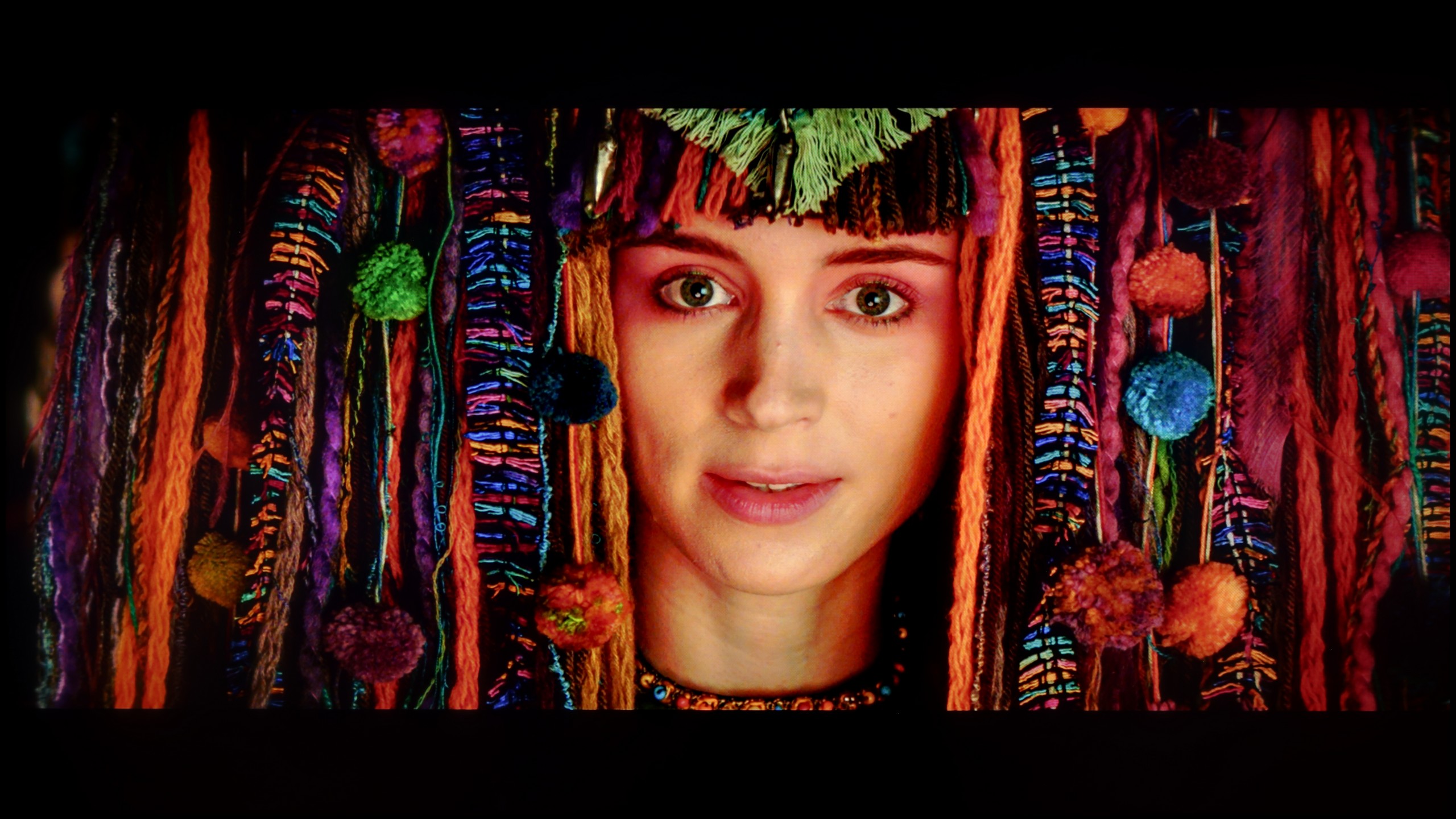
Philips has long provided sophisticated calibration tools, including 2-point and 20-point grayscale adjustments as well as an advanced CMS (Colour Management System). These allow users to make significant improvements, and even those less attentive to image quality will likely notice a positive difference post-calibration. Both SDR and HDR content benefit from this process, notably eliminating the prominent yellow tint caused by an overemphasis on red in the white balance.
For SDR content, although gamma adjustments don’t entirely resolve the loss of detail in dark areas, the overall improvements bring most content to an impressive standard, with minimal, hardly perceptible errors. Colour accuracy is notably enhanced, achieving nearly reference quality with low deltaE errors.
HDR content, however, remains somewhat limited due to the display’s lower brightness capability. While the white balance has largely been corrected, a slight blue tint can occasionally appear. The EOTF curve aligns very well, providing accurate geometry, though colour errors persist due to the limited luminance. This calibration offers a substantial improvement but may still fall short for viewers who expect high brightness levels in HDR.
After calibration, the TCL C7K showed itself in a really good light, especially when it comes to SDR content. We managed to fine-tune the white balance, color gamut, and brightness characteristics so precisely that color errors on the ColorChecker palette dropped below a value of 2. For the uninitiated – this is an almost perfect result, meaning that the image is very close to what the creators intended. Unfortunately, it was less impressive with 4K HDR content. Although we managed to slightly calm the white balance and correct its earlier errors, it is still evident that the TV has certain "MiniLED traits," especially in managing brightness. When we checked how the C7K performed with the EOTF curve on real movie scenes rather than just synthetic test patterns, it turned out that the screen still has a tendency to slightly brighten the entire image. This affects the overall experience – the black loses some depth, and the image becomes less contrasty than it should be. Despite these minor shortcomings in HDR content, the overall reception of materials – especially in SDR – is really very good. After calibration, the C7K can display an image that can successfully compete with much more expensive models. Good color tuning, natural skin tones, and pleasant brightness make movie sessions and everyday content viewing more than satisfactory.
Smoothness of tonal transitions
7/10
8.6/10












In many films or series, you may have noticed instances where colour bands appear in areas that should exhibit smooth transitions. This is why we evaluate tonal transitions as part of our testing. The Philips PML9009 performed admirably in this area across all test scenes. While a few elements could benefit from finer processing, the overall result was impressive. Notably, it handled the challenging scene from The Green Knight exceptionally well, with no significant stuttering or unwanted artefacts visible, proving the TV’s capability to maintain smooth gradients even in demanding scenes.
The TCL C7K handles color gradation very well – in most tested scenes, tonal transitions were smooth, and colors blended together without visible contours or artificial “blot” effects. In everyday use, it’s hard to find fault with it – the image looks natural, without irritating transitions or digital artifacts. Some limitations only appear in very dark tones – especially in a heavily muted gray palette, where the TV may struggle to reproduce ideal gradation. But this is absolutely understandable, because even many significantly more expensive models in this range simply give up. Fortunately, these situations are rare and do not significantly affect the overall perception.
Image scaling and smoothness of tonal transitions
7.2/10
5.5/10
Smooth transition function


Image without overscan on the SD signal


Given the impressive handling of tonal transitions by the Philips PML9009, one might expect similar success in the image scaling test. However, the results were less than stellar. When upscaling lower-quality images, like those from certain TV programmes or older films, the Philips algorithm tended to blur fine details noticeably, especially in intricate elements like fine branches or a model's hair.
On the other hand, the tonal transition performance remains noteworthy, with the TV offering several levels of smoothing. Even at the lowest setting, it effectively addresses non-smooth transitions in most materials, and crucially, it preserves the film grain effect, maintaining fidelity to the director's vision. However, it’s worth noting that some fine details may still appear slightly softened.
The TCL C7K features a function that, according to the manufacturer, is supposed to smooth out unwanted color transitions – something like a rescue for less successful tonal shifts. It's called "Gradual Smoothing" and... well, it sounds ambitious, but in practice, it works very poorly. Regardless of whether we set it to low or high, the difference is minimal. What's worse – the function can remove elements from the image that should remain. Fortunately, film grain remains untouched, so at least it doesn't smooth everything indiscriminately, but still – it's better to just turn this option off.
As for scaling lower-resolution content, it's already better. SD and HD materials look quite decent, though sometimes we had the impression that the image loses sharpness and becomes too soft – as if something took away its clarity. Fortunately, at very low sources (e.g., 576p), there was no overscan effect, meaning the image was not artificially cropped – everything fit on the screen as it should.
Blur and motion smoothness
7.7/10
7.5/10

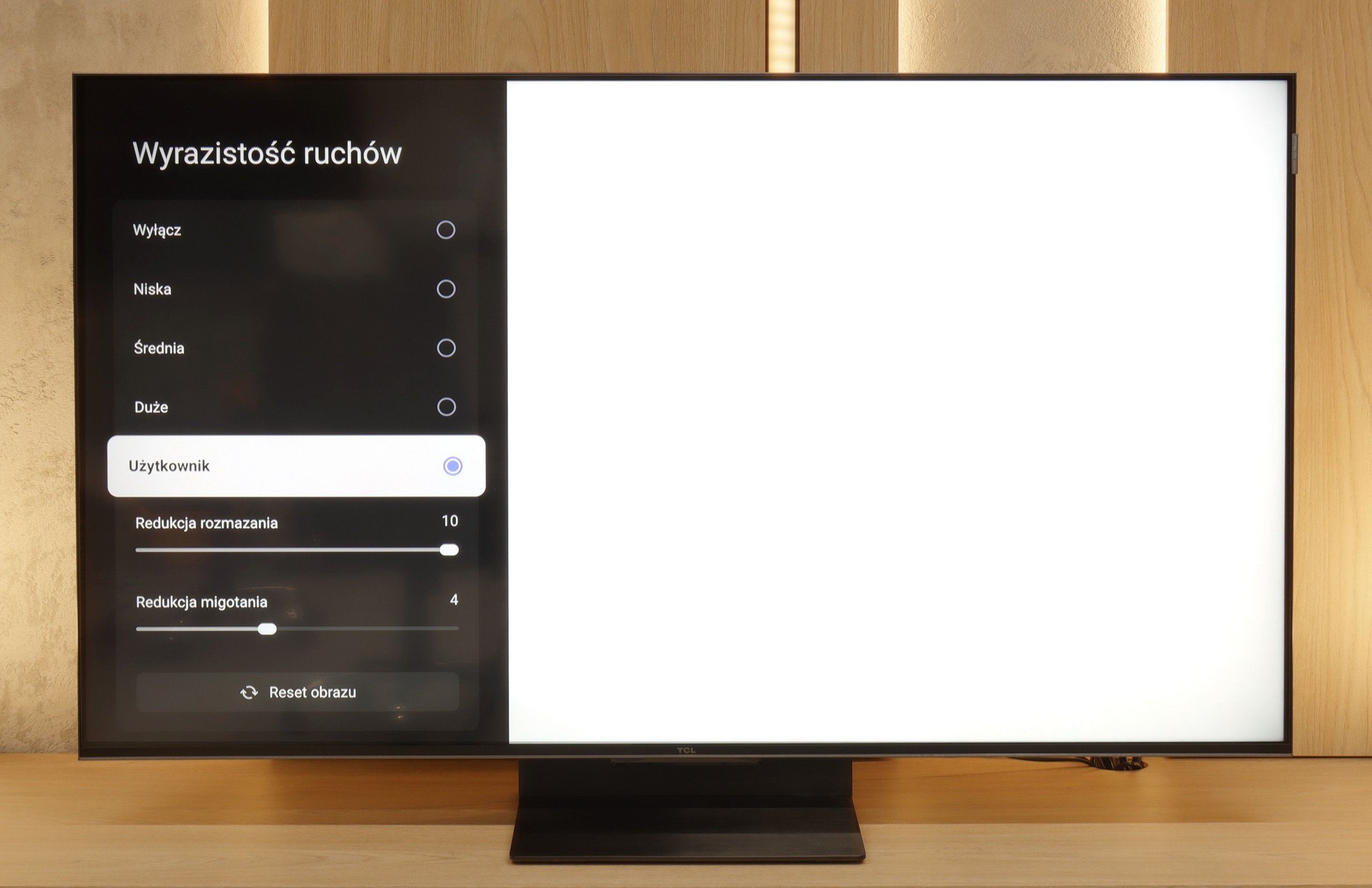
Blur (native resolution, maximum refresh rate):






Blur (BFI function enabled):



Smużenie ():
Smużenie (4K 144Hz):



The Philips PML9009 has a 120 Hz native refresh rate, a baseline standard for watching sports and an ideal setting for gaming on consoles or PCs. Philips includes an effective motion-enhancement system for users who want to reduce the stutter of 24 fps content or need fluid motion for fast-paced scenes, like in football matches. The dedicated "Smoothness" slider effectively mitigates stuttering, while "Motion Blur Reduction" enhances the sharpness of dynamic content. Each setting produces a noticeable difference, so users can tailor the motion effects to their preferences. Our recommended setup achieves a moderate smoothing effect, avoiding the exaggerated “soap opera” appearance.
Regarding pixel response time, VA panels like this generally fall short compared to OLED or even IPS panels, which can lead to a slight "black halo" trailing behind fast-moving objects. Although not a frequent issue with this TV, the effect can be seen in certain scenes.
TCL C7K handles motion smoothness really very well. The matrix used in it offers a refresh rate of 144 Hz, which already suggests that this TV is something more than just an ordinary "60 Hz" panel. Moreover – if we connect the C7K to a computer and set the resolution to Full HD. But we will write more about this in the paragraph about gamers and PC cooperation. Returning to everyday use – both sports and movies look very good here. Thanks to the fast panel and well-functioning motion smoother, the C7K is perfect for watching matches, but also for movie screenings. In the menu, we will find two sliders – blur reduction and flicker reduction – which allow us to adjust the motion smoothness effect to our own preferences. At lower settings, we get a more cinematic effect, with slight frame motion. At higher settings – the image becomes more theatrical, smooth to the point of exaggeration. Everyone can set it to their liking.
Console compatibility and gaming features
9.8/10
9.8/10
- ALLM
- VRR
- VRR range48 - 144Hz48 - 144Hz
- Dolby Vision Game Mode
- Correct implementation of HGIG
- 1080p@120Hz
- 1440p@120Hz
- 4K@120Hz
- Game bar

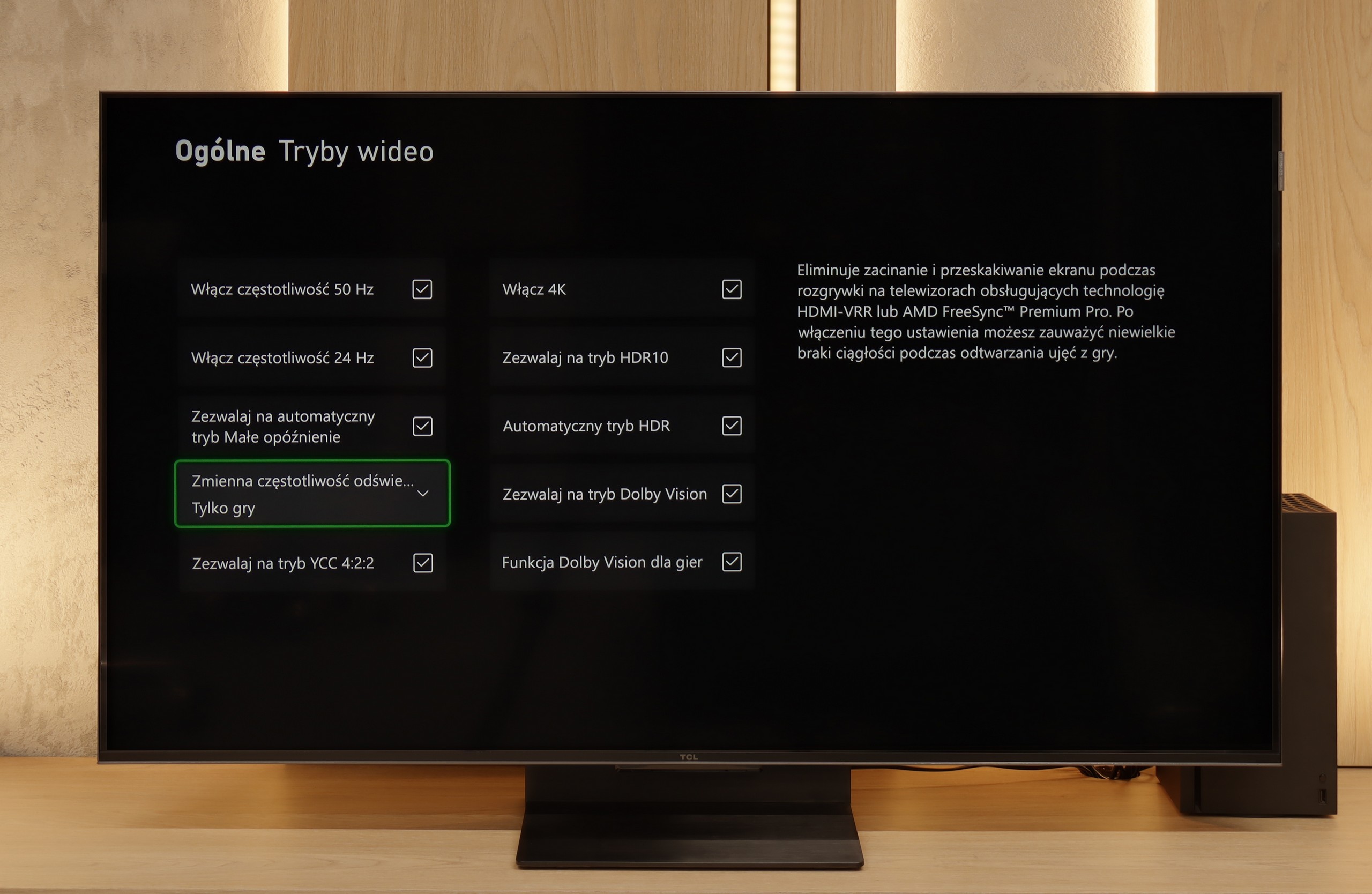

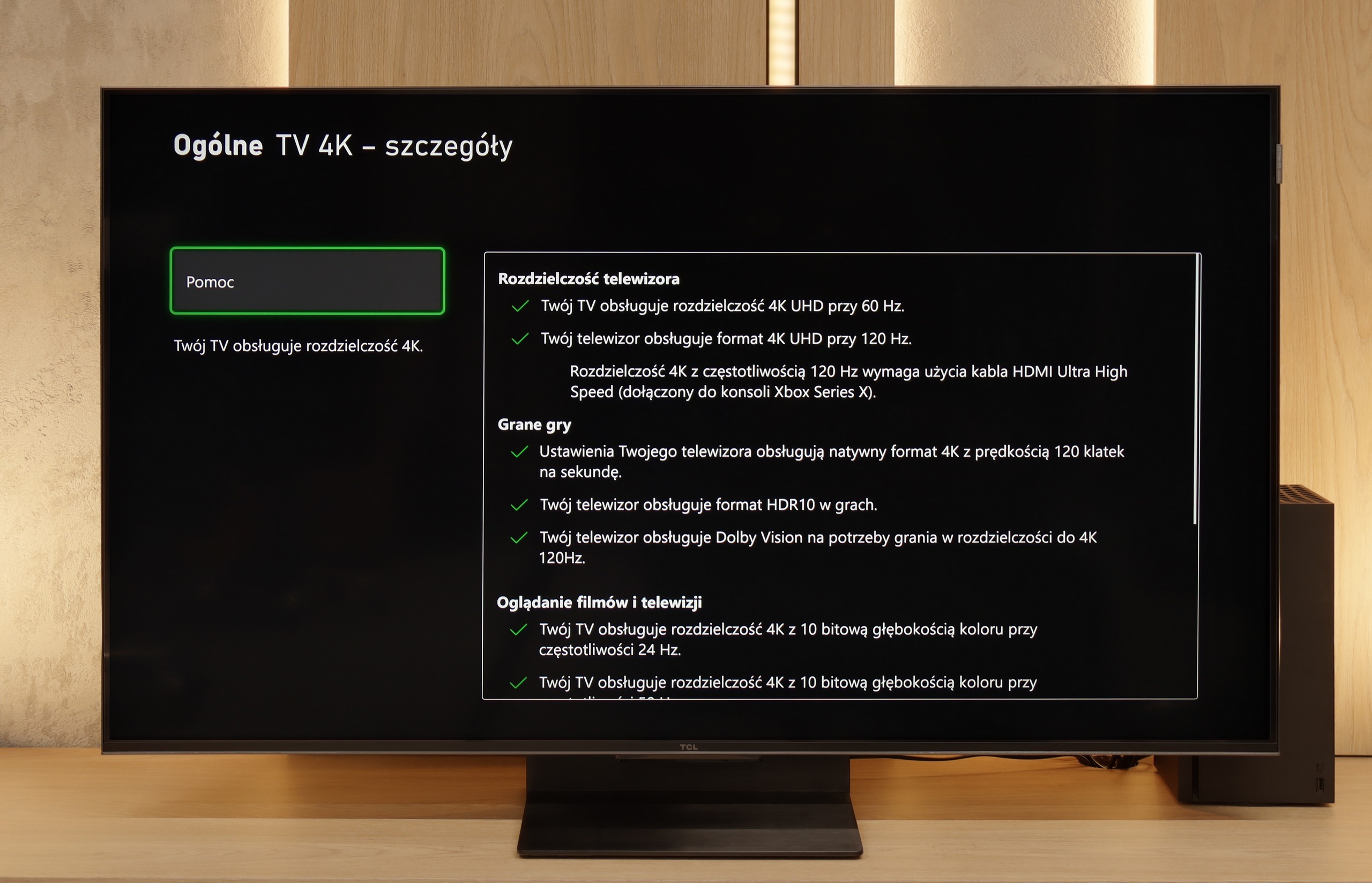

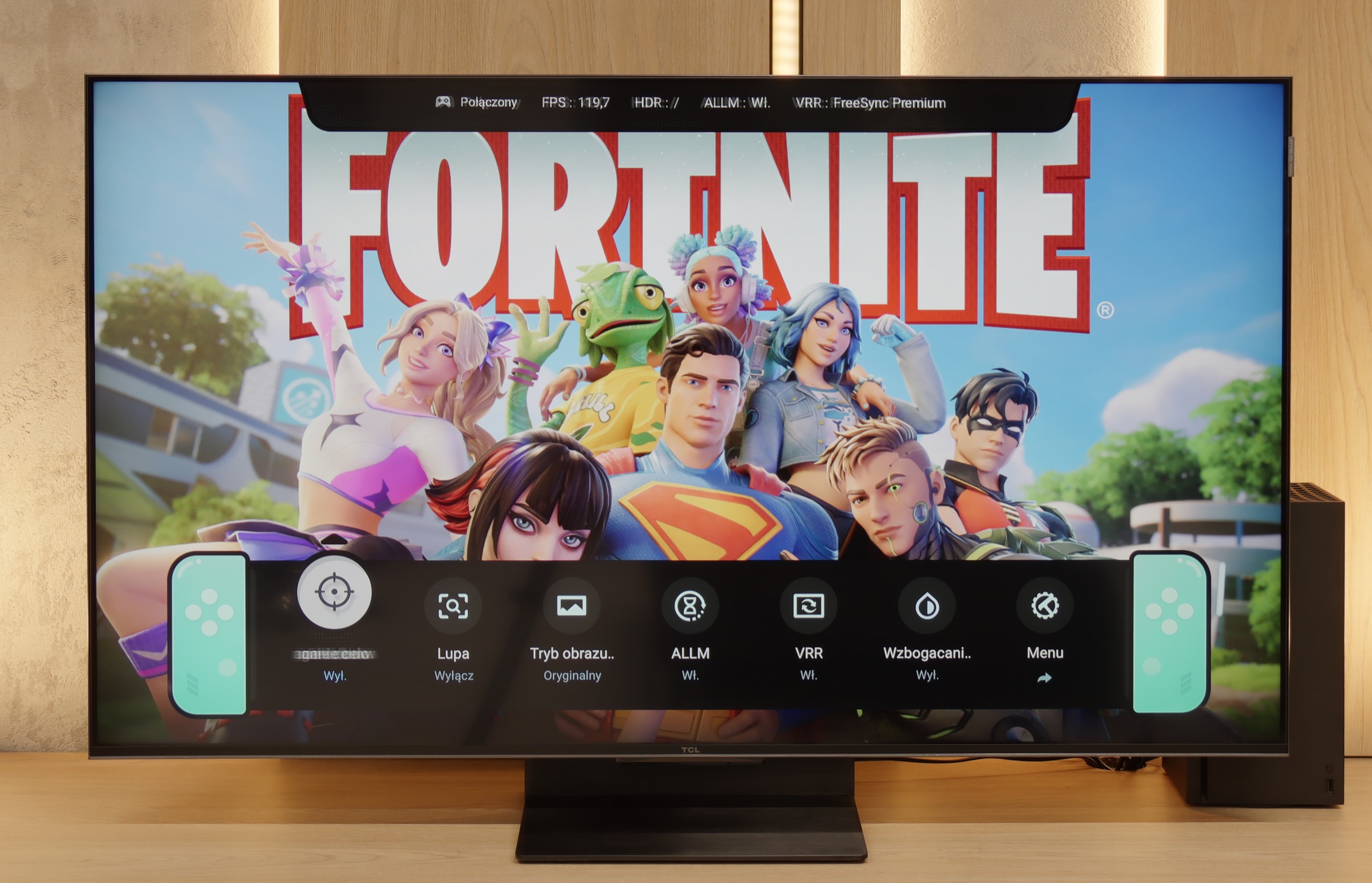

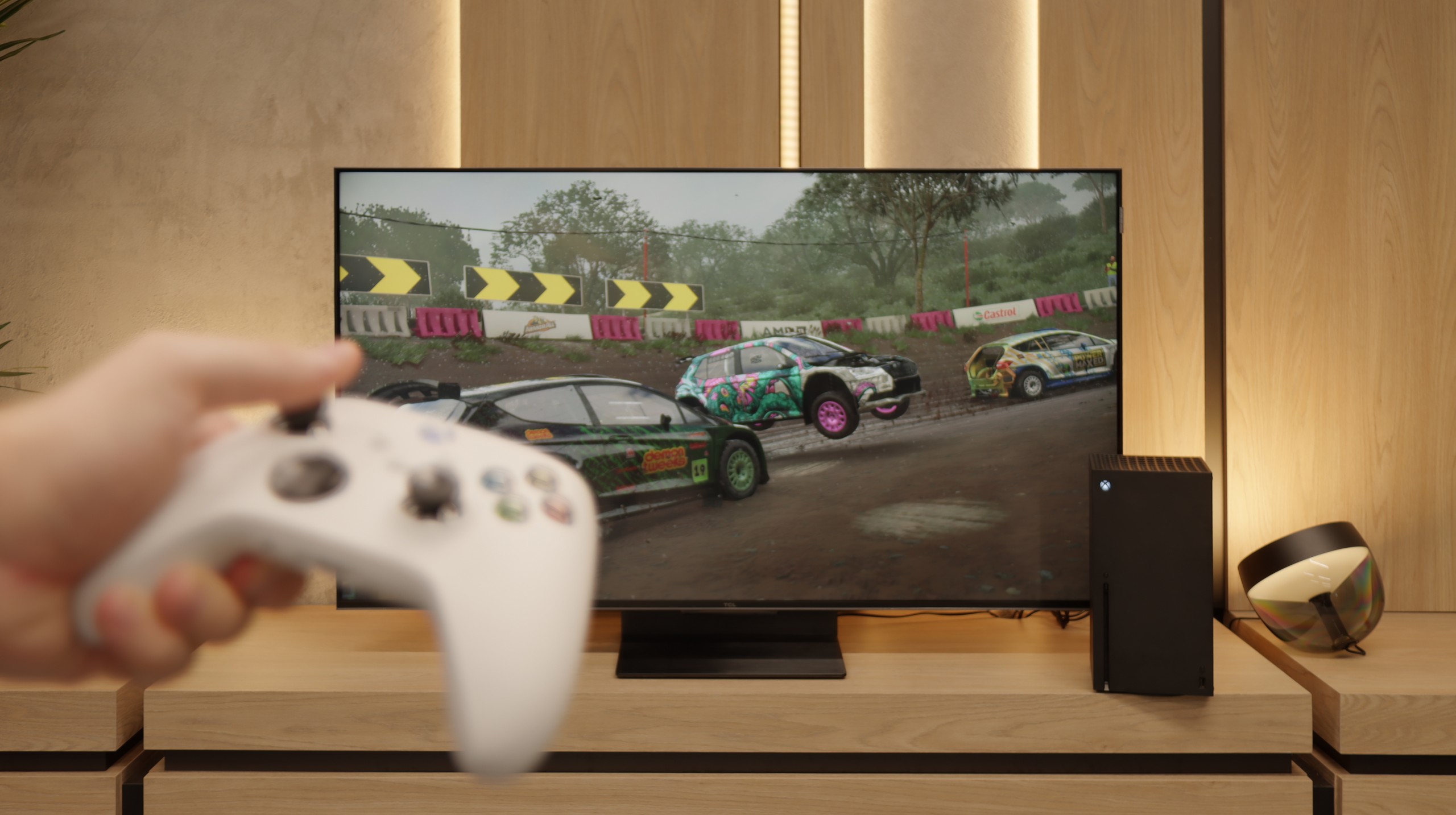
The Philips PML9009, with HDMI 2.1 ports supporting full bandwidth, is thoroughly equipped with gamer-focused features. Core functions like Variable Refresh Rate (VRR) and Auto Low Latency Mode (ALLM) are included, as well as the additional perks of G-Sync and FreeSync compatibility and low-lag HDR Dolby Vision support. All these gaming features activate seamlessly, proving this model’s suitability for gaming. The TV’s HGIG mode, particularly beneficial for gaming, adjusts HDR effects to the television’s capabilities to avoid image dimming and blooming, an advantage given the still limited number of games supporting Dolby Vision.
For added convenience, the PML9009 has a GameBar menu, allowing in-game setting adjustments without needing to exit. This menu includes features like a crosshair option and black level correction, which can enhance the visibility of shadowed areas—ideal for competitive play.
Overall, the Philips PML9009 offers a comprehensive setup for gamers, supporting VRR, ALLM, G-Sync, FreeSync, and HDR Dolby Vision to deliver immersive, high-quality gaming experiences across a wide range of titles.
TCL C7K is a TV that looks like the dream equipment for gamers on paper – and most importantly, it also performs well in practice. First, the good news: we have two HDMI 2.1 ports with full bandwidth, so we can easily connect both a console and a computer, taking full advantage of their capabilities. The panel itself supports 144 Hz refresh rate, which provides a significant advantage in dynamic games. Additionally, it comes with a full package of gaming features: VRR (Variable Refresh Rate), ALLM (Auto Low Latency Mode), and Dolby Vision support in games. There is also an HGiG mode, which allows for HDR effects that align with the creators' intentions. GameBar, which is an information bar for gamers. It operates quickly, looks clear (like a Nintendo console👌), and shows what’s most important: the current frame count, VRR status, and even HDR parameters.
Input lag
9.6/10
9.7/10
SDR
HDR
Dolby Vision
The Philips PML9009 excels in input lag measurements, showcasing impressive performance across various signals and resolutions. Gamers will appreciate the manufacturer’s optimisation, with an exceptionally low input lag of 8 ms when playing at 4K120Hz with HDR—virtually imperceptible even in fast-paced online games. Furthermore, the game mode with Dolby Vision also maintains a commendable response time of 16 ms, ensuring that players experience minimal delay during gameplay. This combination of low input lag and effective game mode implementation solidifies the PML9009 as an excellent choice for competitive gamers seeking a responsive, immersive experience.
When it comes to delays, the C7K doesn't give any reasons to complain. In games at 120 Hz, the input lag is around 10 ms, which means the television responds really quickly. Interestingly, even in Dolby Vision mode, the result is very similar, which is not always the standard. Good job, TCL. At 60 Hz, the lag obviously increases a bit, but that is completely normal and applies to virtually any television with a refresh rate of 120Hz and higher. The most important thing is that everything still runs smoothly and there is no feeling that something is not responding to our actions.
Compatibility with PC
8.6/10
8.4/10

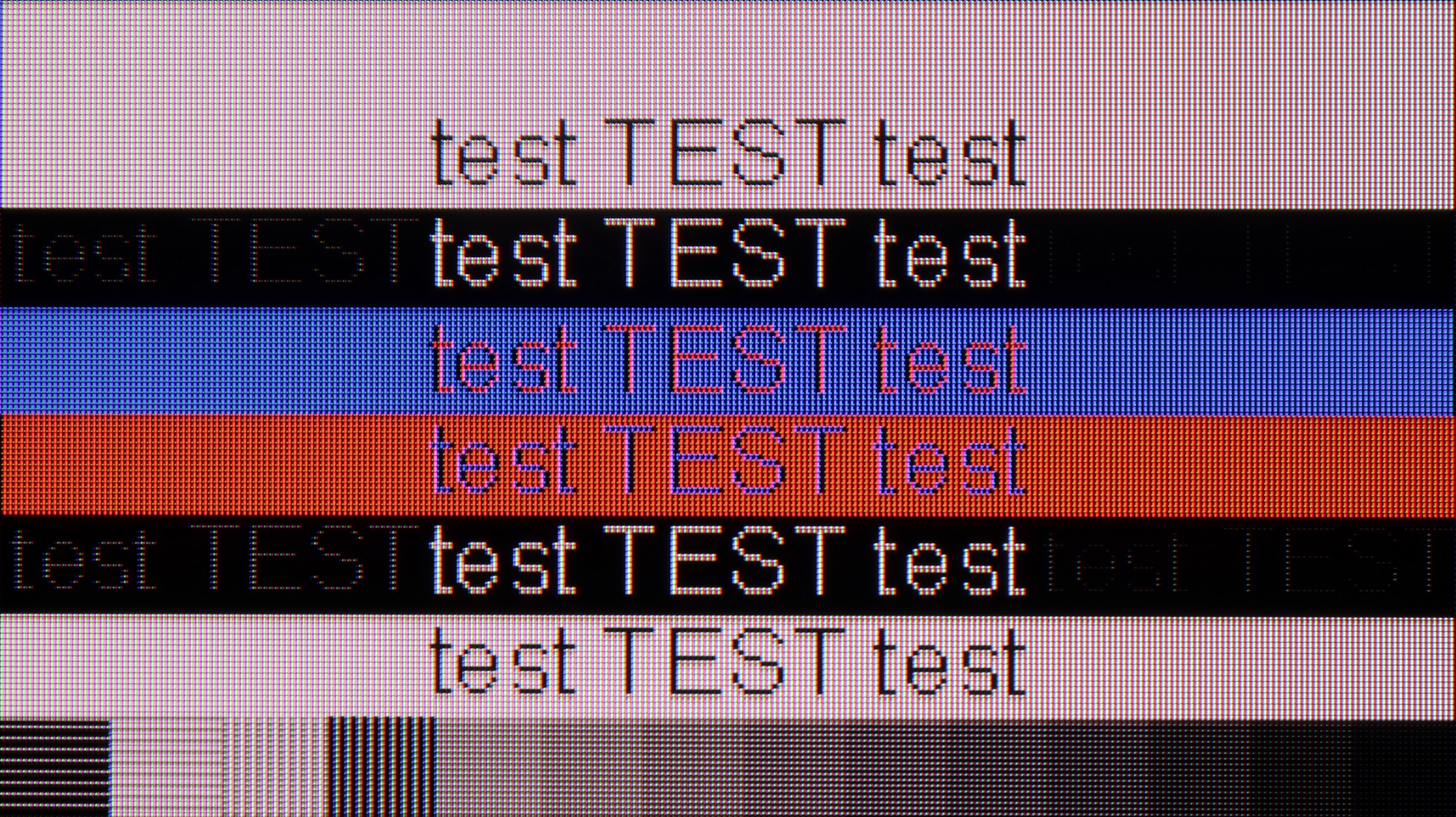
The Philips PML9009 also excels in everyday tasks, with measured delays of just 8 ms providing nearly instantaneous reactions in the mouse-screen-eye connection. Its proper implementation of chroma 4:4:4 ensures crisp, sharp fonts, making it ideal for text work. While the subpixel layout of the matrix is BGR, this doesn't create any issues when using the Windows operating system. However, users on other systems may encounter challenges with text rendering, as those platforms may struggle to convert text accurately. Overall, the PML9009 is a versatile display suitable for gaming and daily productivity tasks.
If we intend to connect the C7K to a computer – especially for gaming – there’s definitely something to play with. We have 4K at 144 Hz, which sounds great on its own, but if we drop the resolution, the TV can display even 280 Hz. In e-sports, where every fraction of a second counts, this makes a real difference. On top of that, there's support for G-Sync and FreeSync, so regardless of what graphics card we have – the image will be smooth, without any stuttering or tearing.
But if we plan to put the C7K on a desk and use it like a monitor, it’s a little less “rosy.” Sure, it supports chroma 4:4:4, so fonts should be sharp, but with very dark letters, there’s a slight blurring and dimming of the edges. It’s not something that immediately stands out during gaming or watching, but when working with text – it can be distracting. In everyday use – probably without concerns, but if we plan to place a 50-inch screen a meter from our face, it’s worth keeping this in mind.
Viewing angles
2.6/10
3/10
A commonly known drawback of VA panels that do not have an angle coating is their poor viewing angles. This is no different this time. Even after a slight shift off-axis, the image becomes washed out, and the colours undergo significant degradation.
There are no surprises here – the C7K has classic viewing angles for a VA panel. That is: sitting directly in front – it’s great. Colors look good, contrast is strong, everything is in place. But just shifting a little to the side and it starts to get worse – the image loses saturation, blacks turn gray, and the overall impression diminishes a bit. So if we plan to watch together with a few people or have a couch that takes up half the living room – it’s worth seating everyone more centrally. You can watch from the side, but don’t expect miracles – that’s just a characteristic of the VA panel.
TV efficiency during daytime
6.1/10
6.1/10




Matrix brightness
Average luminance SDR
TCL C7K / QM7K: 475 cd/m2
Philips PML9009 / 9019 / 9059: 564 cd/m2
While the Philips PML9009 offers good brightness levels for SDR materials—making it suitable for evening or dark-room viewing—the reflection suppression is only average. This can be attributed to the satin finish of the panel, which is prone to reflections from various light sources, as it neither absorbs nor diffuses them effectively. However, the relatively high brightness in SDR mode enables the television to perform adequately in brighter rooms, often outperforming many OLED models in this regard. This makes it a viable option for users who might watch content in well-lit environments.
Fortunately, the TCL C7K performs quite well in a bright room. The applied matrix has a satin finish that effectively reduces reflections, so even on a sunny day, we don't have to worry about reflections from lamps or windows. Importantly, the colors maintain their intensity and do not wash out, as can happen with weaker matte panels. When it comes to brightness itself, the average for content like YouTube or regular TV is slightly below 500 nits. This is not a record result – for example, the MQLED85 (C765) performs better in this regard. However, for everyday watching during the day, it should work without major issues, as long as we don't plan to place it opposite a south-facing window without curtains.
Details about the matrix
Subpixel Structure:

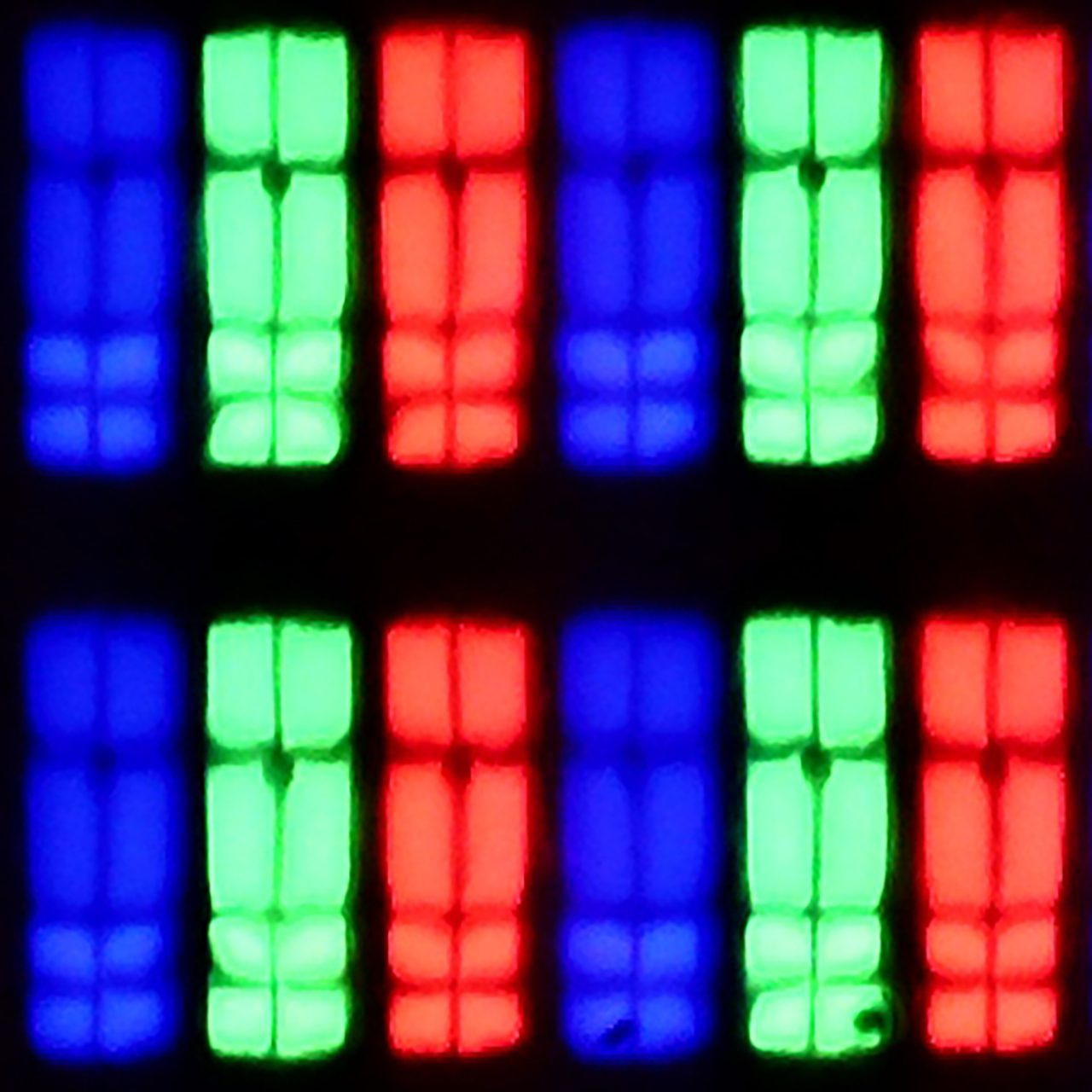
Panel uniformity:


Philips PML9009 / 9019 / 9059
TCL C7K / QM7K
TV features
6/10
7.7/10
- HDMI inputs0 x HDMI 2.0, 4 x HDMI 2.1 48Gbps2 x HDMI 2.0, 2 x HDMI 2.1 48Gbps
- OutputsToslink (Optical audio), eARC (HDMI), ARC (HDMI), Mini-Jack (Headphones)Toslink (Optical audio), eARC (HDMI), ARC (HDMI)
- Network InterfacesWi-Fi 2.4GHz, Wi-Fi 5GHz, Ethernet (LAN) 100MbpsWi-Fi 2.4GHz, Wi-Fi 5GHz, Ethernet (LAN) 100Mbps
- TV receptionDVB-T, DVB-T2, DVB-S, DVB-S2, DVB-CDVB-T, DVB-T2, DVB-S, DVB-S2, DVB-C
Classic features:
- Recording to USB (terrestrial TV)
- Recording programming
- Picture in Picture (PiP)
- RF remote control (no need to aim at the screen)
- Backlit remote control
- Teletext
- Audio only mode
- Possibility to connect Bluetooth headphones to the TV
- Possibility to simultaneously use Bluetooth headphones and the TV speaker
Smart features:
- AirPlay
- Screen mirroring (Windows Miracast)
- Wyszukiwanie głosowe
- Voice search in native language
- Ability to connect a keyboard and mouse



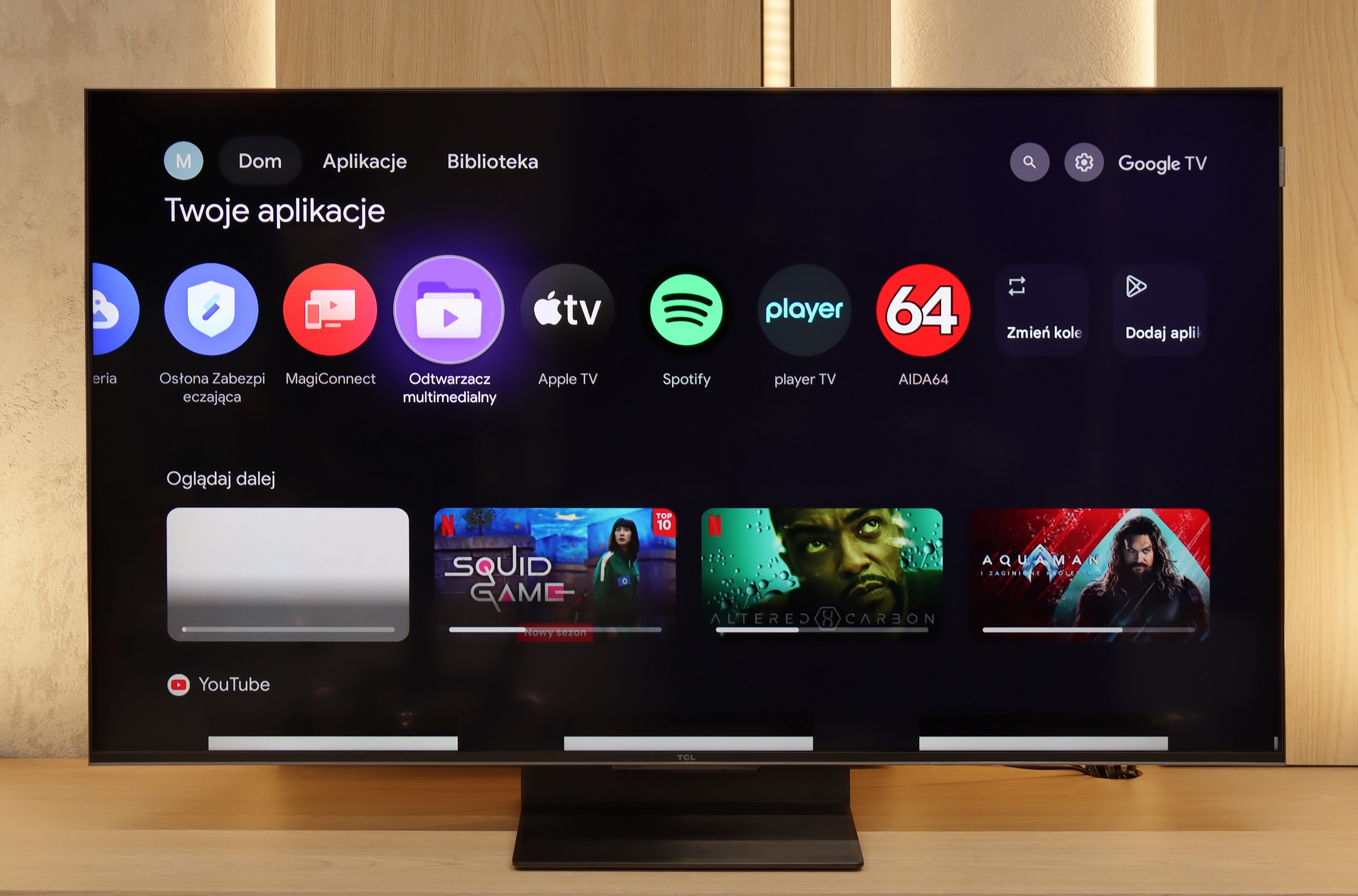
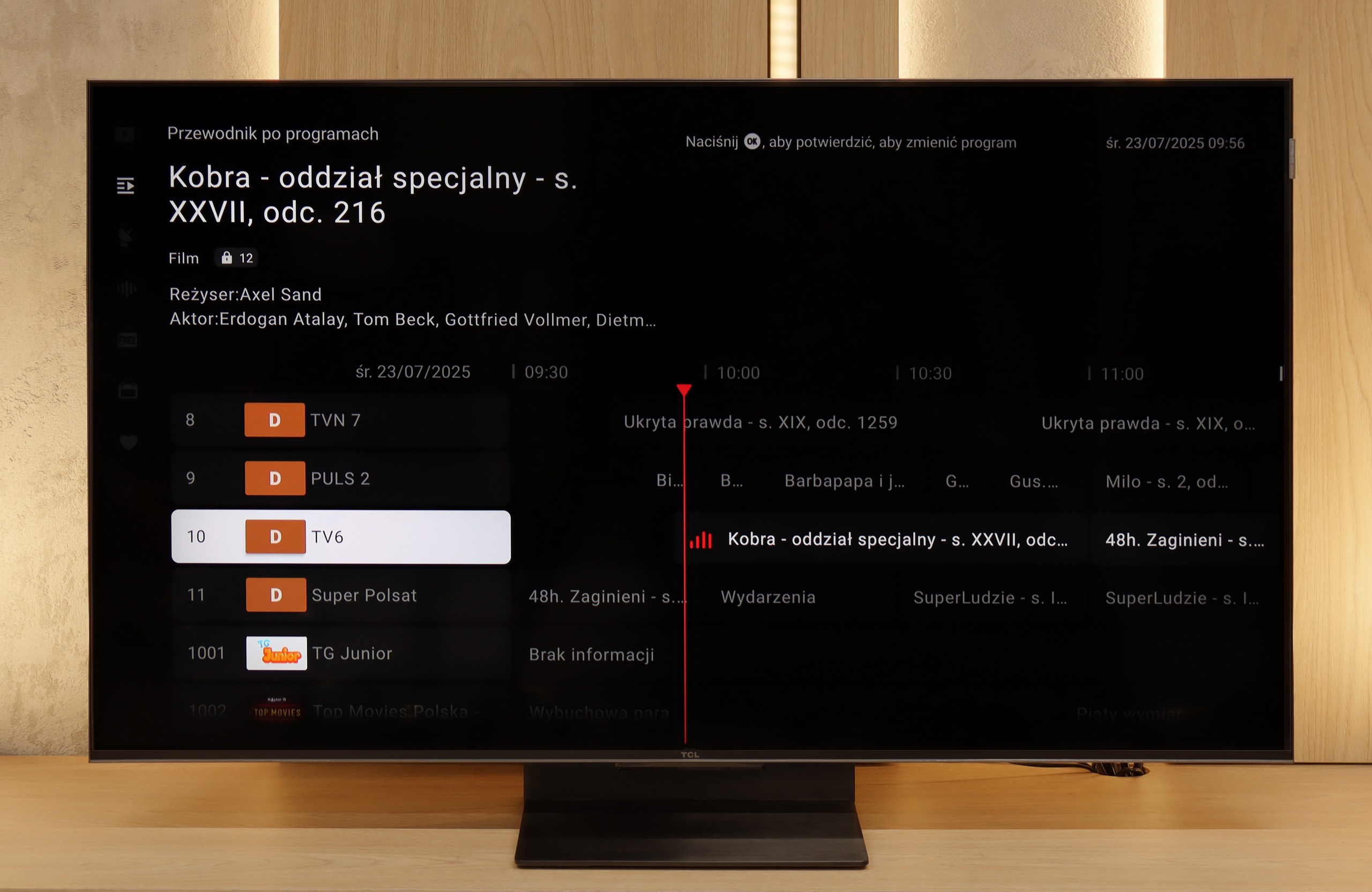
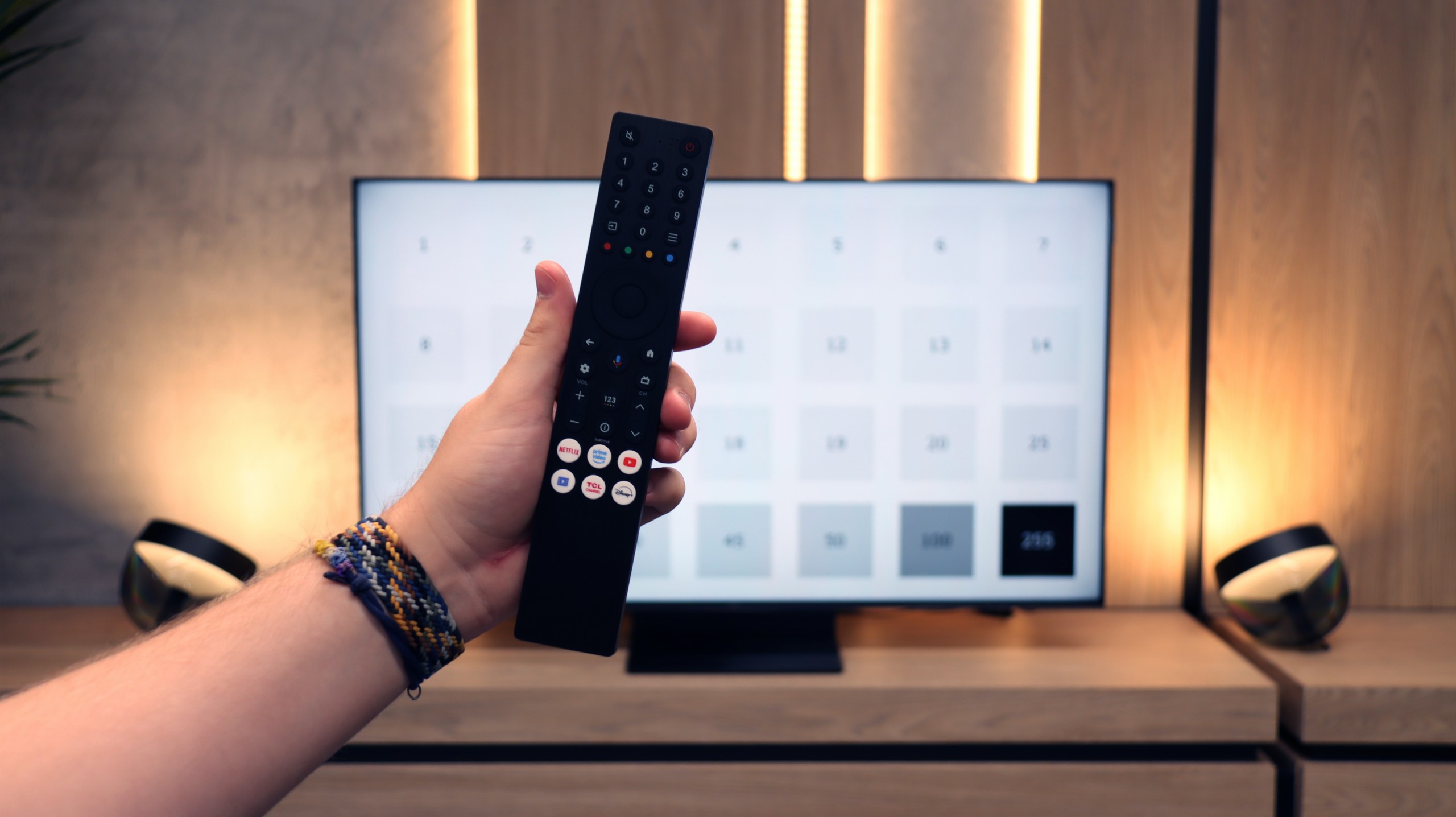
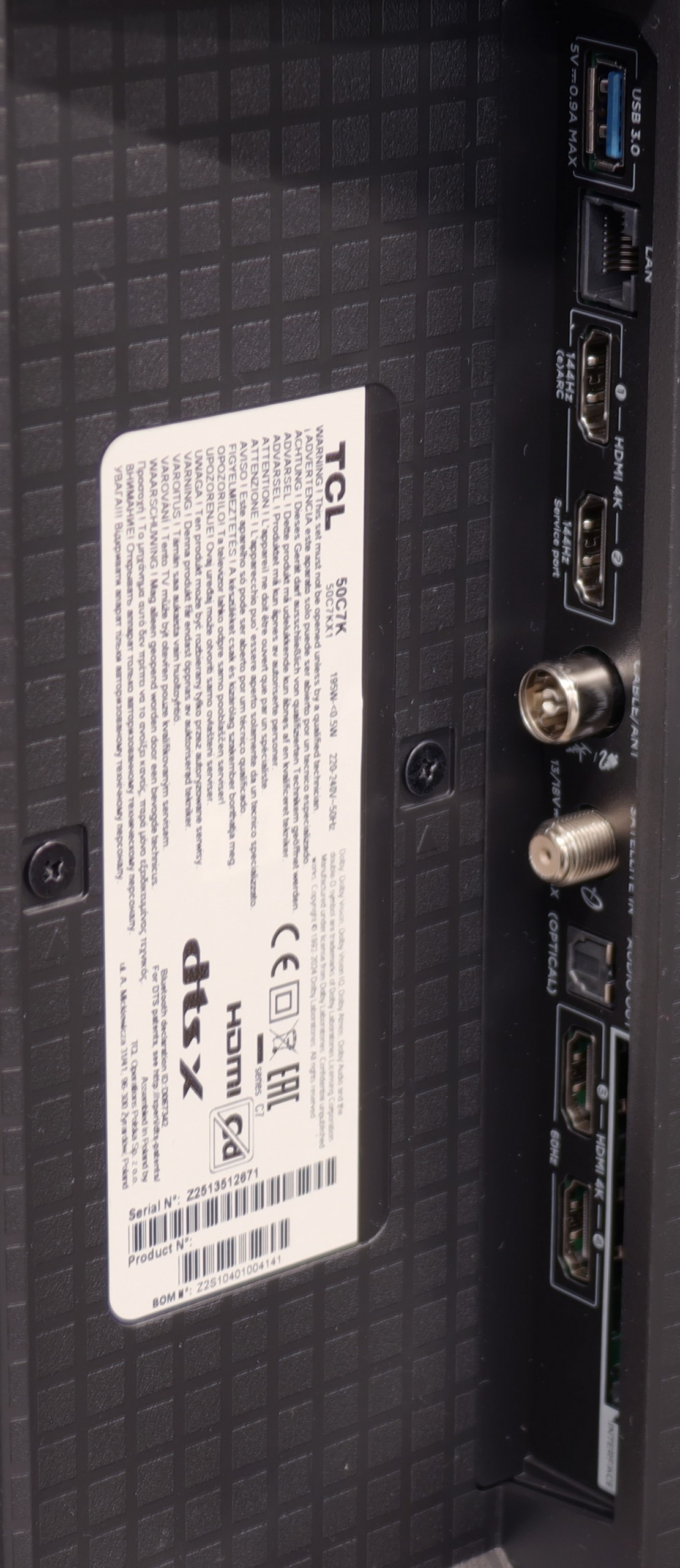
Before delving into the software that powers the Philips PML9009, it’s essential to highlight one of the standout features of the manufacturer’s TVs: the multicoloured Ambilight backlighting. This unique feature enhances the viewing experience by projecting colours from the back of the TV that correspond to the on-screen action, creating a more immersive atmosphere.
The operating system used in the PML9009 is Philips' proprietary TitanOs. While it offers some benefits, it is notably more closed and limited when compared to other models that use the Google TV system. One significant drawback is the absence of essential applications such as Apple TV, MAX, Canal+, and Player. Additionally, TitanOs restricts users from performing basic tasks like scheduling recordings or recording to USB. Apple device users may also be disappointed by the lack of AirPlay functionality, which allows for easy screen sharing.
On a positive note, the TV supports connecting a keyboard and mouse, which can simplify navigation through the menu. However, it's worth noting that while the remote pairs via Bluetooth for voice selection in English, all other functions rely on infrared (IR) connectivity.
In summary, TitanOs has its limitations, especially for users who frequently utilize a variety of streaming platforms. It seems better suited for those who primarily engage with a few key services—what one might refer to as the "holy trinity" of streaming: Netflix, YouTube, and CDA.
SmartTV: GoogleTV
The greatest strength of the TCL C7K in everyday use is undoubtedly the Google TV system. Thanks to it, we have access to an almost endless library of apps, including more niche ones that are often unavailable on other platforms. The built-in Google Assistant understands Polish, so we can easily ask what's on TV, what the weather is like, and even give a few voice commands to control the television. It's also worth noting the presence of Chromecast and AirPlay, which work smoothly and make life easier.
Usability Features
On the downside, the classic features are somewhat lacking. Of course, we find the basics here – teletext, EPG, or the ability to connect headphones – but that's pretty much it. There's a lack of USB recording functionality or picture-in-picture (PiP) mode, which can sometimes still be found with the competition. It's also worth remembering that the Google TV implementation on TCL can sometimes have oddly translated menu sections or minor interface bugs. These are not issues that hinder everyday use, but detail-oriented individuals may notice them.
Playing files from USB
8.2/10
9.2/10
Supported photo formats:
Maximum photo resolution:


The default media player integrated into the Philips PML9009 provides a fairly comprehensive set of features but does have certain limitations. It supports nearly all common video formats except for the relatively rare .asf format. However, users may encounter issues due to the absence of the H.265 HEVC codec for high-bitrate content and a lack of support for .sub subtitle files, which are popular among many users.
With photo playback, the media player performs adequately, though it does not support some widely used resolutions and formats, such as HEIC, commonly found on Apple devices. The player excels in audio playback and leaves little room for criticism.
Unfortunately, the system's limitations prevent users from extending the player’s functionalities, meaning users are confined to the capabilities the manufacturer has included. This can be a drawback for those who rely on specific formats or additional features not provided by the built-in player.
The built-in media player in the TCL C7K performs really well. It supports most popular audio and video formats, so if we want to quickly throw something from a USB drive and play it – there shouldn’t be any problem. Of course, as is usually the case, there are some minor shortcomings – not every exotic codec will work (Apple's HEIC), not all subtitles will be perfectly synchronized (txt.). However, this is where the biggest advantage of this TV comes in, which is Google TV. With access to the Google Play store, we can easily install an alternative player, like VLC, and then no file is intimidating to us.
Apps
6.2/10
9.6/10














































Sound
6.7/10
7/10
- Subjective sound quality:6.7/107/10
- Dolby Digital Plus 7.1:
- Dolby True HD 7.1:
- Dolby Atmos in Dolby Digital Plus (JOC):
- Dolby Atmos in Dolby True HD:
- DTS:X in DTS-HD MA:
- DTS-HD Master Audio:
At the outset, it is worth noting that sound quality is a subjective matter. The built-in audio system in the Philips PML9009 is characterised by clear high tones, but the bass is quite flat and significantly worse than in competing models in the same price range.
To be honest, we didn't expect much from the sound in the 50-inch version of the C7K model. Usually, in such sizes, it's hard to get anything more than a thin, flat sound. But here – a pleasant surprise. The sound turned out to be really enjoyable, with good clarity and even a slightly perceptible bass. This is probably related to TCL's new collaboration with the Bang & Olufsen brand, which is new for 2025. Whether the C7K actually features original drivers from the Danish premium brand – we can't confirm. But the final effect is still deserving of a plus. For a TV without a soundbar – it sounds quite nice.


